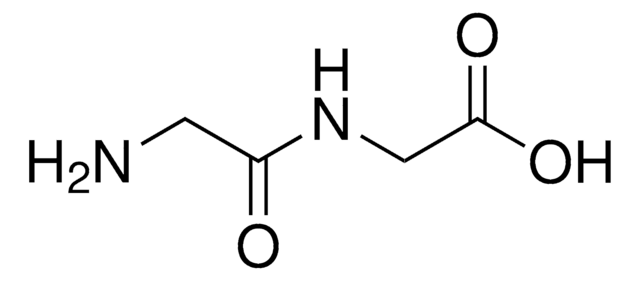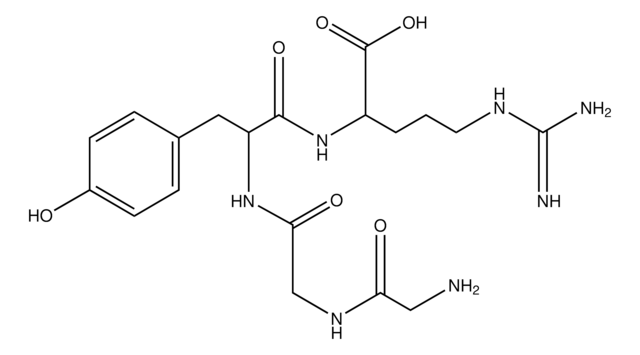50239
Gly-Gly-Gly
≥99.0% (NT), suitable for ligand binding assays, BioUltra
Synonym(s):
Glycyl-glycyl-glycine, Triglycine
Sign Into View Organizational & Contract Pricing
Select a Size
All Photos(1)
Select a Size
Change View
About This Item
Linear Formula:
NH2CH2CONHCH2CONHCH2COOH
CAS Number:
Molecular Weight:
189.17
Beilstein/REAXYS Number:
1711130
EC Number:
MDL number:
UNSPSC Code:
12352209
PubChem Substance ID:
NACRES:
NA.26
Recommended Products
Product Name
Gly-Gly-Gly, BioUltra, ≥99.0% (NT)
product line
BioUltra
Quality Level
assay
≥99.0% (NT)
form
powder
technique(s)
ligand binding assay: suitable
impurities
insoluble matter, passes filter test
ign. residue
≤0.1% (as SO4)
loss
≤0.5% loss on drying, 110 °C
color
white
Looking for similar products? Visit Product Comparison Guide
Amino Acid Sequence
Gly-Gly-Gly
General description
Gly-Gly-Gly or triglycine is a flexible peptide linker with three glycine residues linked by peptide bonds in a linear sequence. Gly-linkers link multiple domains in a single protein without affecting the function of each domain.
Application
<ul>
<li><strong>Targeting PEPT1: a novel strategy to improve the antitumor efficacy of doxorubicin in human hepatocellular carcinoma therapy:</strong> Research explores Gly-Gly-Gly peptides as potential enhancers for drug transport efficiency, positioning them as valuable tools in clinical diagnostic peptide development for targeted cancer therapies (Gong et al., 2017).</li>
<li><strong>Iminopyridine complexes of manganese, rhenium, and molybdenum derived from amino ester methylserine and peptides Gly-Gly, Gly-Val, and Gly-Gly-Gly: self-assembly of the peptide chains:</strong> This study demonstrates the use of Gly-Gly-Gly in the synthesis of complex metal-peptide frameworks for potential use in high-purity peptide applications in IVD manufacturing (Álvarez et al., 2012).</li>
</ul>
<li><strong>Targeting PEPT1: a novel strategy to improve the antitumor efficacy of doxorubicin in human hepatocellular carcinoma therapy:</strong> Research explores Gly-Gly-Gly peptides as potential enhancers for drug transport efficiency, positioning them as valuable tools in clinical diagnostic peptide development for targeted cancer therapies (Gong et al., 2017).</li>
<li><strong>Iminopyridine complexes of manganese, rhenium, and molybdenum derived from amino ester methylserine and peptides Gly-Gly, Gly-Val, and Gly-Gly-Gly: self-assembly of the peptide chains:</strong> This study demonstrates the use of Gly-Gly-Gly in the synthesis of complex metal-peptide frameworks for potential use in high-purity peptide applications in IVD manufacturing (Álvarez et al., 2012).</li>
</ul>
Biochem/physiol Actions
Substrate for reproducible serum protein measurements by the biuret reaction and for the assay of aminotripeptidases.
Storage Class
11 - Combustible Solids
wgk_germany
WGK 3
flash_point_f
Not applicable
flash_point_c
Not applicable
ppe
Eyeshields, Gloves, type N95 (US)
Choose from one of the most recent versions:
Already Own This Product?
Find documentation for the products that you have recently purchased in the Document Library.
Customers Also Viewed
Our team of scientists has experience in all areas of research including Life Science, Material Science, Chemical Synthesis, Chromatography, Analytical and many others.
Contact Technical Service








